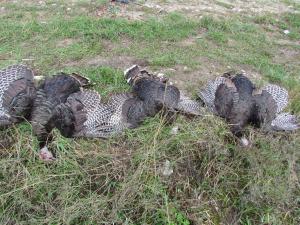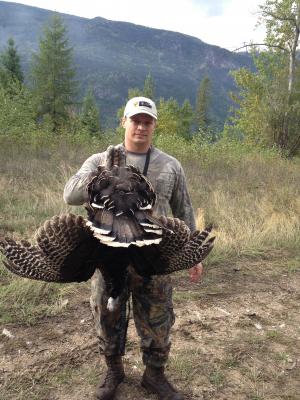Scouting For Wild Turkeys
Scouting For Wild Turkeys
Scouting forms the most important part of wild turkey hunting. 
If a number of turkeys are spotted at a particular location in winter, it would be unwise to expect them to be found at the same place later in spring.
Scouting turkey also involves looking at their droppings. The shape and size of the droppings clearly indicate, whether the bird is a hen or a gobbler. Hen droppings can be distinguished by their looped, spiraled or bulbous shapes of just over 1/4 of an inch in thickness, whereas gobbler droppings are thicker, averaging 1/2 an inch with shapes being straighter or J shaped. The sizes of the turkey tracks also can tell you the sex of the bird. Tracks about 3 1/2" in length are hen tracks, while Gobbler tracks are longer; nearly 4 1/2" in length.
If you are an avid turkey hunter, the best way is to scout all the year round. The best time of the day for scouting wild turkey is just after dawn, listening for turkey gobbling around creeks, fences, pastures and trails. When they are sighted, also look around to locate places that would place you at a higher level while taking a shot.
 Whenever you spot turkey or some one gives you information where turkey have been seen in large numbers around the countryside, just make a note of the place and the time of the day, they are spotted. After locating a general area with turkeys around, you need to find out key locations to increase your chances of success. You can do this by looking for roosting locations, strut zones, dusting and scratching areas. These areas and the travel routes falling in between are some of the best places to set up for calling in a gobbler.
Whenever you spot turkey or some one gives you information where turkey have been seen in large numbers around the countryside, just make a note of the place and the time of the day, they are spotted. After locating a general area with turkeys around, you need to find out key locations to increase your chances of success. You can do this by looking for roosting locations, strut zones, dusting and scratching areas. These areas and the travel routes falling in between are some of the best places to set up for calling in a gobbler.
You need to be careful while scouting turkey so you do not scare them away. The birds have very keen eyesight. Therefore, during scouting you must ensure wearing clothing that blend with the colors of the plant life around the countryside and that break up your shape. Wear jackets, trousers, caps, facemasks and gloves etc., which do not appear incongruous with the surroundings and scare the turkey away. This way you can take advantage of the landscape to hide behind bushes, rocks, tall grass and trees to obscure your approach while scouting.
Wherever there is good nesting habitat, both hens and gobblers can be found. While tracking gobblers, just locate areas with lots of hens. If you find the hens, you are sure to find gobblers nearby.
During your turkey scouting trip, you will need a good pair of binoculars along with a good pair of boots and a game scouting camera. This will comprise your basic turkey scouting equipment. You can set up the camera on a suitable tree to automatically take pictures at pre-determined intervals according to the settings you make on the unit. The camera and flash can usually be used to take pictures or video clips at 5/10/15/20 minute intervals or when an animal trips the sensor. A variety of game scouting cameras from different manufacturers are available in the market and may cost you anywhere from $100 to $500, depending on the sophistication of the camera features.

